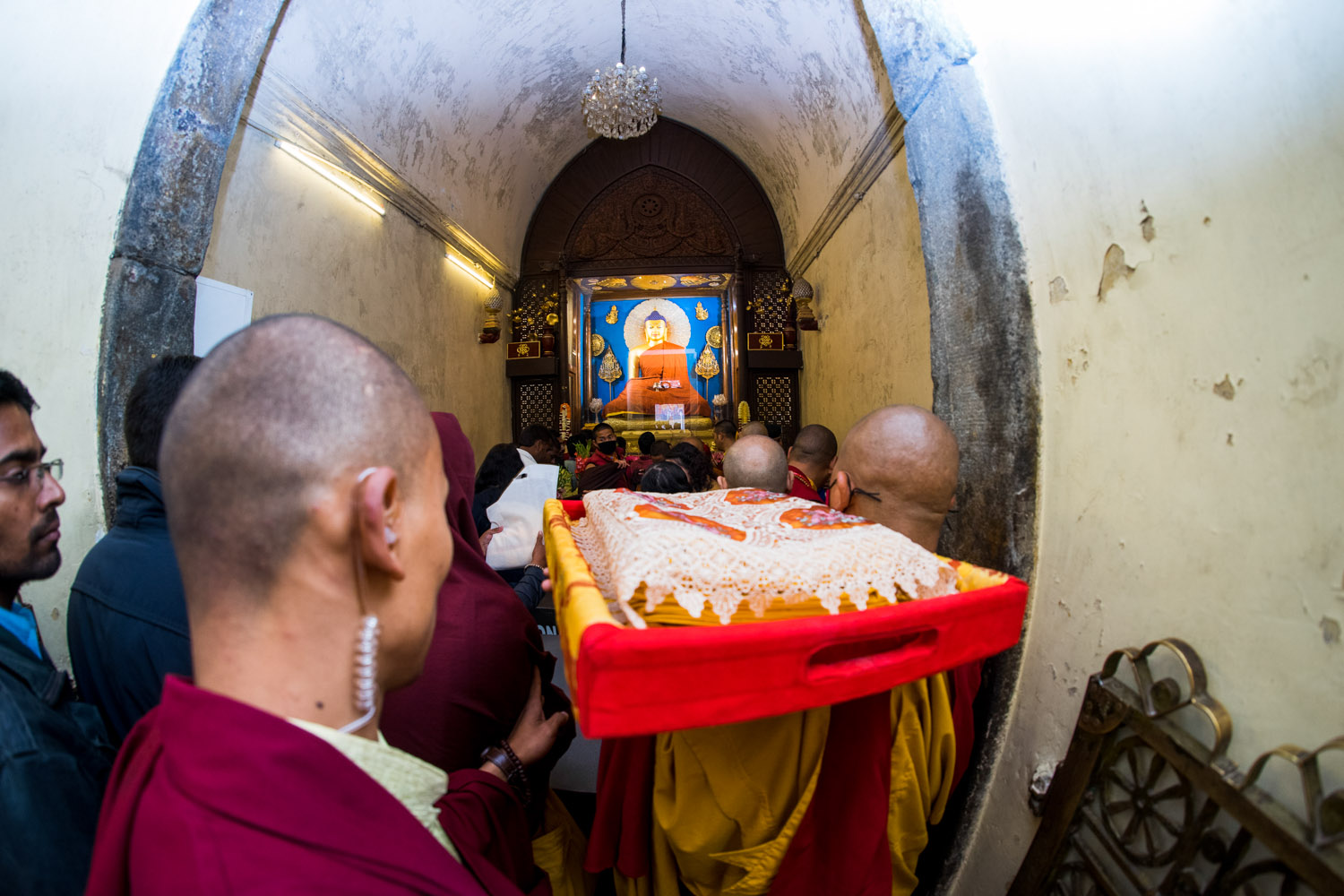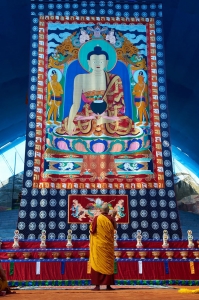A brief look at the background of who the Shakyamuni Buddha was, the major events of his life, and the incredible legacy that he left behind for the world with the creation of Buddhism.
The birth of the Buddha
In 563 or 566 B.C.E., a prince was born to a noble family of the Shakya clan, in a very beautiful park called Lumbini Grove, which lay in the foothills of the Himalayas (in present-day southern Nepal). This beautiful park was not far from the capital city of the Shakya kingdom, Kapilavastu. The prince’s father, King Shuddhodana, named his son Siddhartha. He was a member of the Kshatriya, or royal warrior caste, and his clan lineage, the Gautamas, was ancient and pure. His mother was Mahamaya or Mayadevi, daughter of a powerful Shakya noble, Suprabuddha. Before the conception of Siddhartha, Queen Mahamaya dreamed that a white elephant, extraordinary and utterly beautiful, entered her body. Soon after the birth, soothsayers predicted that the young prince would become either a Chakravartin, a universal monarch, or an “awakened one,” a buddha. So from the very beginning of his birth, he showed signs of perfection.
Life as a prince
Seven days after the birth, Queen Mahamaya died; her sister, Siddhartha’s aunt, Mahaprajapati Gautami, who was also married to King Suddhodana, thereafter raised and brought up Siddhartha like her own child, with great care and love, in the wealthy circumstances of a noble family.
His father naturally wanted his son to be his successor and provided him the very best possible education and pleasurable occupations. He tried to prevent Siddhartha from coming into contact with any religious or spiritual path in order to steer him toward becoming the next king of the Shakyas.
As a young prince, Siddhartha was fully educated and mastered the arts and sciences of his day, including even the art of war and other trainings, displaying a sharp intellect and the strength and power of a great physique. When the young prince reached the age of sixteen, he married Yashodhara and engaged in the pleasures of the world. He continued to relish the comforts of the palaces, gardens, and varieties of wealth of the royal lifestyle.
The renunciation of his kingdom
In his late twenties, Prince Siddhartha encountered the “four signs” during excursions from the palace. They made an extremely strong impression on him. These signs were: an old man, a sick person, a corpse, and a monk or a yogin. Through them he realized that the vanity of youth, as well as one’s health, and even life, may end at any time; furthermore, he realized that the only way out of this suffering world of samsara was through finding and following the right spiritual path.
At twenty-nine, after the birth of his son, Rahula, Siddhartha left the palace and kingdom behind and engaged in an ascetic path. He became a homeless, wandering yogi, seeking the truth for the sake of all sentient beings. He began to practice, mainly under the guidance of two ascetic teachers, Arada Kalama and Rudraka Ramaputra.
The enlightenment of the Buddha
When Siddhartha realized that he was not reaching his goal, liberation, he gave up the ascetic way of life and turned to meditation, deciding to seek enlightenment on his own. After six years of hardship and practicing near Nairanjana River, he began to travel and gradually came to the region of Gaya. Siddhartha went to Bodhgaya, where he sat under what was later to be known as the Bodhi-tree, vowing to exert himself in his meditation until he reached his goal of enlightenment.
NOTE: During the 2021 summer teachings, the Gyalwang Karmapa taught extensively on the detailed history of the life of the Buddha, as well as the Indian landscape that allowed Buddhism to spread and flourish for future generations.

Jamgon Kongtrul, Karmapa, and Gyaltsab Rinpoche in front of the famous statue of Shakyamuni Buddha in the Mahabodhi Temple, Bodhgaya.
After forty-nine days, at the age of thirty-five, Prince Siddhartha attained complete enlightenment, or buddhahood, overcoming all the obscurations and temptations of Mara. At this point, Siddhartha was a buddha, a fully awakened or enlightened one, and he knew that for him, there would be no further rebirth in samsaric realms.
Teaching and benefiting beings
Seeing that what he had achieved was not possible to communicate directly, he remained silent for seven weeks. Buddha gave his first discourse in Deer Park in Benares, which is known as “the first turning of the wheel of dharma.” In this discourse, he taught the four noble truths, the interdependent nature, and the law of karma, at the request of Indra and Brahma. His earlier five ascetic companions became his first disciples and began to form the bhikshu (monastic) sangha. At Vulture Peak Mountain near Rajagriha, Buddha turned the second wheel of dharma, in which he taught the nature of all phenomena as being shunyata or emptiness and anatma or selflessness. There followed a period of many years of teaching at a variety of places, such as Vaishali. The teachings of this period are known as the third turning of the wheel of dharma, in which Buddha taught a variety of subjects, including the notion that all sentient beings possess tathagata-garbha – the basic heart of buddha.
Through these teachings, Buddha showed the way that leads all beings to the experience of awakening and liberation from samsara. This demonstrates clearly his limitless compassion and loving-kindness towards all beings who are looking for liberation and freedom from the realms of samsaric existences.

Inside the Mahabodhi Temple in Bodhgaya, new robes are offered to the statue of Shakyamuni Buddha as part of the Kagyu Monlam festival. Photo thanks to Keith Liao.
King Bimbisara of Magadha became a follower of Buddha and offered a monastery near Rajagriha, the capital of Magadha, which became very important historically for the development of the sangha. Buddha spent a great deal of time mainly in the region of Rajagriha and Vaishali, moving from place to place and living on alms. The number of his followers grew very fast. Buddha’s most important students were Kashyapa, Shariputra, Maudgalyayana, and Ananda. Buddha later founded orders of nuns, or bhikshuni, and had many followers and establishments in these regions.
Since he was born as the prince of the Shakyas, after his enlightenment he was known as “the Shakyamuni” or “the Sage of The Shakyas,” and from his clan name, he was later called Gautama Buddha.
During his life, his cousin, Devadatta, who had always been jealous of what Siddhartha had achieved, sought to become the head of the Buddha’s sangha or community. Devadatta planned to destroy the Buddha. Though he did not succeed, he brought about a schism among the monastic communities in Vaisali that caused great harm to the sangha’s spiritual development.
The death of the Buddha
At the age of eighty, Shakyamuni Buddha empowered his close disciple, Kashyapa, as his regent to continue the sangha’s activities. Lying on his right side and facing west, Buddha entered into parinirvana. (Other accounts and some sutras state that Buddha partook of spoiled food, which caused him to pass away.) His relics are distributed and enshrined in seven stupas and elsewhere. The main pilgrimage site for buddhists is Bodhgaya, India, the site where Shakyamuni attained enlightenment.
Here is a video from inside the Mahabodhi Temple at Bodhgaya, the site where the Buddha attained enlightenment, right next to the Bodhi Tree. The Gyalwang Karmapa is making offerings to the famous statue of the Buddha Shakyamuni during the Kagyu Monlam.



